|
|
Expedition
Expedition | People
|
Log - July-30-2003
by Gerhard Behrens and Robert McCarthy
Previous | Next
Celebrity
Robert McCarthy |
| Lee Narraway is on the deck! Lee Narraway is on the deck! Quick, get your cameras! No, there are no paparazzi onboard, but anyone and everyone with a camera is following her. Why? Who is Lee Narraway you might ask. And why is everybody scurrying for their cameras? |
| Well, she is a freelance photographer and journalist who has lived in or near Ottawa for most of her life. Being a Canadian citizen, she is traveling on the Healy as an observer, essentially being the public’s eye. But she’s been almost everywhere. Lee has given photography classes in Australia, Nunavut, and Chile, and she has raced sled dogs. She also is head coach of a rowing club. Lee has seen a lot, and because of her skills, knowledge, and artistic ability with both camera and pen, others can see and read about the places she’s been. |
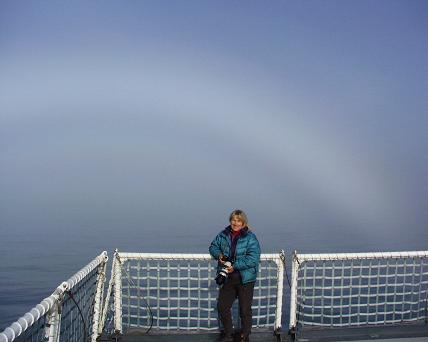 |
| Lee learned the “ART” of photography by trial and error, starting her photographic career working for a newspaper. She had access to a lot of film there, and honed her skills by doing. She has a very keen eye, and her attention to detail is amazing. She contributes regularly to “Above & Beyond”, Canada’s Arctic Journal which is published every 2 months. Her photographs have appeared 3 times on the cover of “Above & Beyond” over the last 3 years. So, when she’s around on the deck with camera in hand, she attracts a lot of attention. Either to see the world the way she sees it, watch her “do her magic”, or to get insightfull comments from her on how to take better pictures. PLUS, the stories she can tell about her other shoots makes you envious of the things she’s experienced and captured on film. |
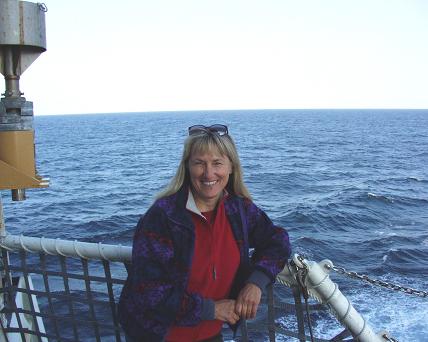 |
Two days ago, while heading towards Pond Inlet, we experienced very light winds. The warm air over the cold ocean again produced fog, but the sun was trying to peek through. I was on the flight deck with Lee, taking some pictures of the scientists preparing to test the horizontal ranging of the acoustic releases, when there appeared a “fog-bow”, as Lee called it. (See fig 1) In principle, it is the same as a rainbow, but the color is washed out since the size of the drops of water are much smaller in fog. Clouds and fog are composed of tiny water droplets, that are not heavy enough to fall as precipitation. (If you’ve ever been driving in a car through fog with your hand out of the window, your hand will become wet.) So I’ll illustrate how rainbows are formed, and the principle is the same for the smaller water droplet found in fog. A typical fog drop size is 5 microns, whereas the smallest rain drop is on the order of 500 microns. So a minimum size difference of 100 times or more. Since fog is at least 2 orders of magnitude smaller, the refraction of light doesn’t occur to the same degree as in a raindrop. So the dispersion of light into the colors of the rainbow is washed out. Here’s how a rainbow is formed: |
| Sunlight strikes a water droplet and refracts while it passes into the droplet. Refraction is just the bending of waves due to a change in velocity. Since light travels slower in water than in air, the light ray bends downward (in a direction more towards the normal to the surface) and travels through the drop to the other side. This ray then reflects off the back surface of the drop and comes back out of the front of the drop. However, since the light ray will now be traveling faster in air, the ray bends the other way (in a direction away from the normal to the surface.) The different colors of the rainbow are due to the changing speeds of the different wavelengths of light. Red light is bent the least, while violet light is bent the most. From the diagram, it would appear that the rainbow should have violet on top, but for the violet light to reach our eyes, the drop has to be lower in the sky (has to come from drop #2). Hence we all know the ROYGBIV acronym from elementary school days, with red on top and violet on the bottom. Some of Lee’s work can be seen at http://www.above-n-beyond.com. Tomorrow I will continue with optics and talk about cameras and lenses. |
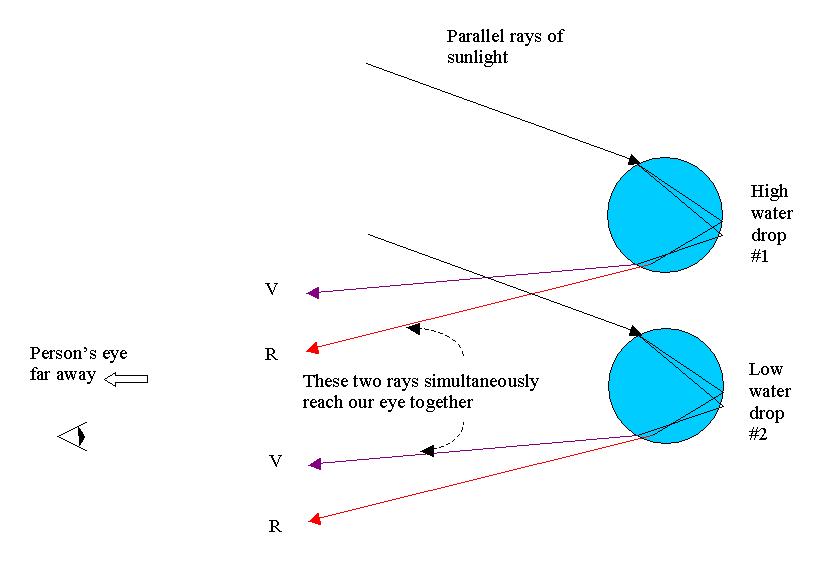 |
A day of coring
Gerhard Behrens |
| Yesterday, I wrote that Monday’s big news was the helicopter operation to Pond Inlet. The next thing to catch everyone’s attention was the coring part of our cruise. I hope you remember that a core is when the workers drive a long, steel pipe into the bottom of the ocean and bring back a big tube of dirt. The coring team worked from Monday, around midnight, until Tuesday, around midnight: 24 hours of work! |
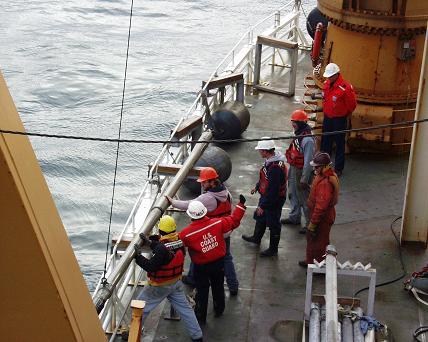
A team of people gets the core ready on the deck. |
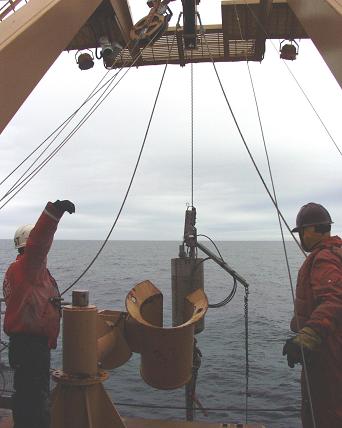
A lot of cables and cranes are needed to move the 6000 lb core. |
But this dirt is special. It is called sediment. Glaciers laid down these layers of sediment over ten thousand years ago. By studying the very thin layers, scientists can learn more about the history of this place. That will help us understand what we see now and might see in the future. |
| An easy way to imagine coring is to place a straw into a glass of milk, put your finger on top of the straw, and pull it out. Just as you come out with a sample of the milk, the core comes out with a sample of sediment. Of course, it isn’t that easy. Keep reading to find out what makes this a difficult and dangerous job. |
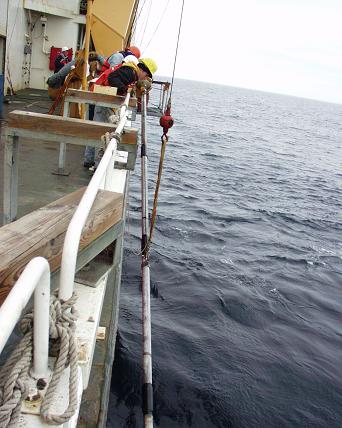
The core is lowered into the water. |
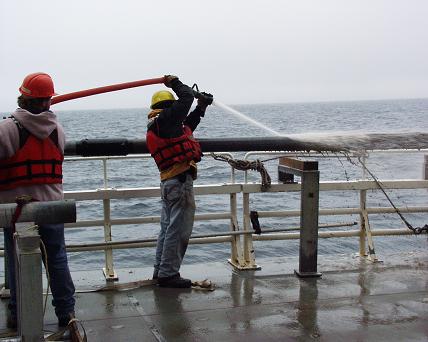
Washing mud off the core after it comes out. |
First, using special maps of the bottom of the ocean, a team of scientists has to decide where to place the core. Second, the core is long, about 40 feet. It’s not that easy to move a 40-foot section of steel pipe around. Third, it is VERY heavy. 5500 lbs of weight at the top of the pipe helps drive the pipe deep into the sea bottom. Fourth, the ship has to stay as still as possible so the core can go in straight and come out straight. Can you imagine keeping a 420-foot, 36 million pound ship still? Fifth, the sediment has to be cut into 1.5-meter sections (about 5 feet) and stored in a refrigerator to be studied in labs back on shore. Everyone must wear steel-toed shoes, a life vest, and a hardhat. |
| Once again, a team of people works together to make the coring possible. Two cranes help lift the long and heavy core in and out of the water. Coring technicians make sure the pipe and all its pieces are put together correctly. The ship’s pilot, with the ship’s computers, gently steer the ship to keep it in place. The technicians cut and label each section for storage and later study. Hopefully, the pictures help you understand. |
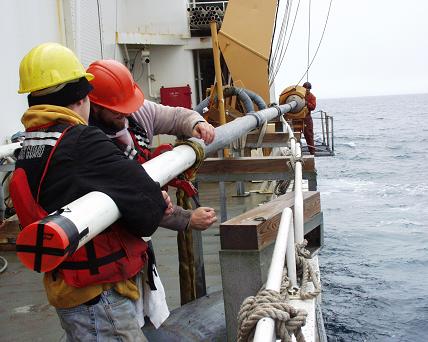
Cutting the core into 150cm (5ft) sections. Notice the end cap. |
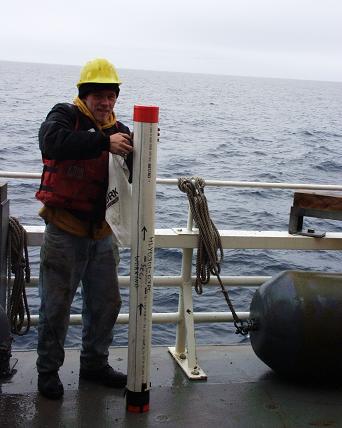
An historic 150cm of sediment from Baffin Bay. |
Just like life off the ship, things can go wrong. One coring try ended up with lots of water in the tube instead of dirt. The core hit a layer of gravel that stopped it from going deep into the ocean bottom. Darn! For another core, the ship’s bow thruster (an engine that helps keep the ship in one place) broke. Thanks to the skill of the pilot, and thanks to light winds, the coring team was able to get a great sample. |
| Who is interested in the layers of sediment at the bottom of Baffin Bay? Here is a short list of scientific areas that will study the earth’s history, geology, and biology with this very special dirt: sedimentology, mineralogy, geochemistry, geomorphology, micropaleontology, paleomagnetics, ocean engineering, and civil engineering. |
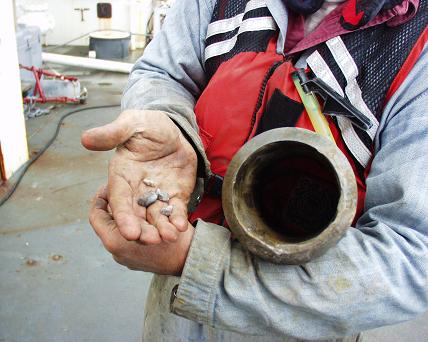
A bed of gravel like this blocked the core at one spot. |
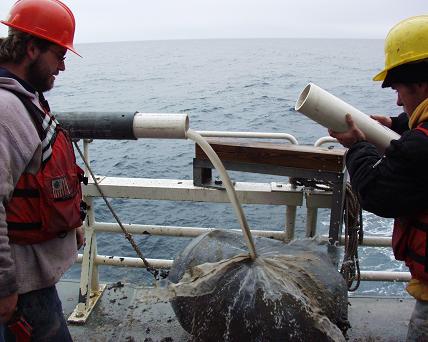
The core brought back water, not much sediment, this time. |
|
